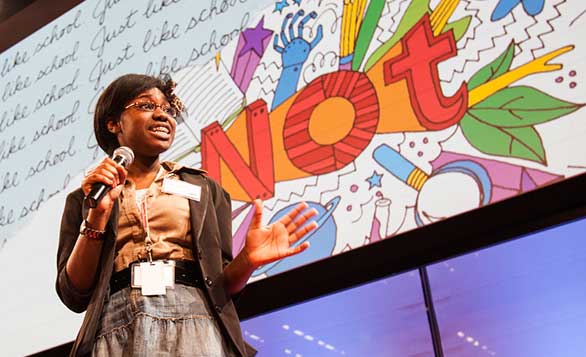
A student from the audience introduces a speaker at TEDYouth 2012, themed “Just like school … not.” Photo: Ryan Lash
What conference, besides TEDYouth, could bring together an elephant communication expert, the head of research at Pixar, a professional storm chaser, and a 16-year-old DJ? TEDYouth 2013, “The Spark,” happens tomorrow, November 16, at 11am CST in New Orleans, Louisiana. And you can watch along via the live webcast, which will be available in English, Spanish and Arabic. To get you ready for this fast-paced, mind-blowing conference, here’s a playlist of some of the best talks from TEDYouths past.
Adam Savage: How simple ideas lead to scientific discoveries
Adam Savage is the host of Mythbusters, and the king of making scientific analysis fun. In this talk from TEDYouth 2011 — which happens to be half animated — he shows how simple methodologies led to two of the most exciting scientific discoveries of all time: Eratosthenes’ calculation of the Earth’s circumference and Hippolyte Fizeau’s measurement of the speed of light.
Greg Gage: The cockroach beatbox
At TEDYouth 2011, Greg Gage dissected a cockroach on stage. In this talk, amped up with animation, we get a deeper look at how their brains work as he manipulates the electrical impulses between the leg and brain. Because roach brains are so much like ours, if we understand how they work, we can understand how we work.
Carvens Lissaint: “Put the Financial Aid in the Bag”
Education should be more affordable. In this spoken-word gem from TEDYouth 2011, performance artist Carvens Lissaint imagines what would be said during a robbery for scholarships and Pell Grants.
Katherine Kuchenbecher: The technology of touch
At TEDYouth 2012, Katherine Kuchenbecher shares why she is working hard to make haptic feedback a part of everyday technology. What is “haptic”? Anything related to the sense of touch. Imagine being able to touch a fabric as you shop online, or your dentist being able to “feel” a cavity from a scan.
[ted id=1371]
Kevin Allocca: Why videos go viral
Kevin Allocca watches YouTube videos professionally (he is the site’s trends manager). At TED2011, he shares the magic behind what makes videos go viral, narrowing it down to four factors.
Maurice Ashley: Working backward to solve a problem
Maurice Ashley is a chess grandmaster. And in this talk from TEDYouth 2012, he shares one method he uses to improve his game — using retrograde analysis to work backward from the endgame he desires. He shares why this is useful in chess … and life.
Tom Chi: Rapid prototyping Google Glass
It didn’t take years, or even months, to prototype Google Glass. It was done in a single day. In this talk from TEDYouth 2012, Tom Chi — who was on this prototyping team — shares how they did it using binder clips and clay.
Robert Full: Curiosity, discovery and gecko feet
How do geckos stick to walls and trees? It has to do with their hairy toes. At TEDYouth 2011, Robert Full tells the story of how a sophomore in college solved this mystery by creating a beautifully simple way to measure the force of a single gecko hair.
William Gurstelle: A call to invention
Speakers, made of a used yogurt cup? In this talk from TEDYouth 2012, tinkerer William Gurstelle shows you how to make them.
David Fasanya and Gabriel Barralag: “Beach Bodies”
In another truly amazing spoken-word moment, this time from TEDYouth 2012, David Fasanya and Gabriel Barralag bring down the house. This reflection on self-image begins, “I don’t know about you, but I’m trying to get this beach body…”
Comments (11)
Pingback: 14 Free Web Tools and Apps for Students to Present Their Knowledge – ESL Library Blog
Pingback: 8 Tools to Drive Lifelong Learning in Title I Schools
Pingback: Best of the Web: February 12, 2016 | ASIJ HS Library/Tech Updates
Pingback: Take a stand! Respond to the following: | LANGUAGE AND LITERATURE 2014/2015
Pingback: Why Videos go Viral. | Level 3 Media